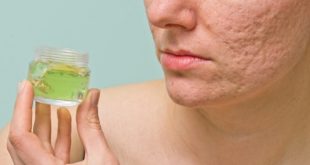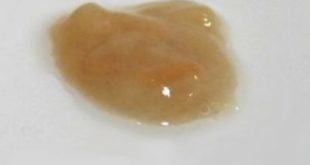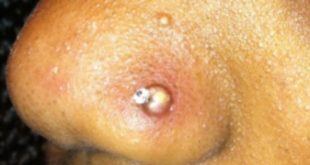Dry skin (xerosis) may not be serious most of the time, but experiencing it is not comfortable. It is not only that but lines or wrinkles could manifest, making your skin look older than it is. You can experience dryness anywhere on your body: the arms, face, and legs. And then there’s dry skin behind the ears.
Dry red skin behind ears
Contents
There are many different kinds of dry skin. They can include red patches, patches with flakes or scales, or even areas that develop fissures that bleed. Specifically for this condition, it has been established that it could be a result of seborrheic dermatitis.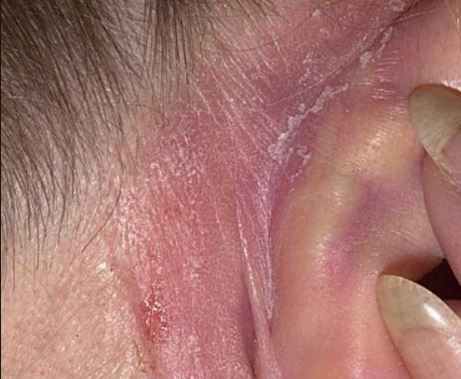
It is a dermatological condition that may be caused by stress, yeast known as malassezia, cold winter weather and, in some cases, from diseases like HIV and AIDS or Parkinson’s disease, according to MayoClinic.com. Further, flaky, dry ears may also be caused by a skin allergy from fragrances, shampoos, lotions or any other substances you use around your ears.
Seborrheic dermatitis causes flaking or the formation of thick scales that frequently affect the face as well as the scalp as well as the ear. When it gets to the scalp, it could lead to formation of dandruffs but on the ear, it forms dry skin.
If you are affected with seborrheic dermatitis you are likely to show different symptoms. It can be widespread on the body, affect two areas, or target a single area. The effect on the ear can be so disturbing and irritating. The symptoms below give you light into this condition.
- Areas of the affected skin may feel sensitive, sore and itchy. Flaking skin may be bothersome or embarrassing if you are affected.
- Affected skin areas may appear red with greasy flakes.
- Flaky ears due to seborrheic dermatitis may be accompanied by yellow or white crusty scales on the surface of the skin that turns red with time.
- When this condition shows up around and in the ears, you are bound to have inflammation behind the ears, in the ear’s cup, and inside the ear canal. Bacterial infection can cause the skin to crust.
- Flaking skin on the ears due to an allergic reaction may be accompanied by hives, blistering skin, itchy skin or a strange rash [American Academy of Allergy Asthma and Immunology].
Dry skin behind baby’s ear
The appearance of flaky and dry skin behind the ears of your toddler could be an indicator of either eczema of seborrheic dermatitis. You could finish up this by often applying petroleum jelly or checking with your pediatrician for proper diagnosis and treatment thereafter.
See also:
In this case, there will no need for any treatment. All you do is just cleanse with a mild, hypoallergenic soap. Any rashes that are oozing or accompanied by a fever (which can indicate infection) and those that seem to get worse with simple treatment, need the attention of a specialist.
Causes of dry skin behind ear
Can Psoriasis cause the skin to dry behind the ear? Psoriasis is a chronic skin condition that is characterized with raised red scaly patches affecting both sides of body. White skin scales are peculiar of this condition. It may occur behind the ear and on scalp. The lesions are small and circular while others may join to form plaques. Itching is not uncommon and most patients complain of intense itching and scratching resulting in bleeding from the area.
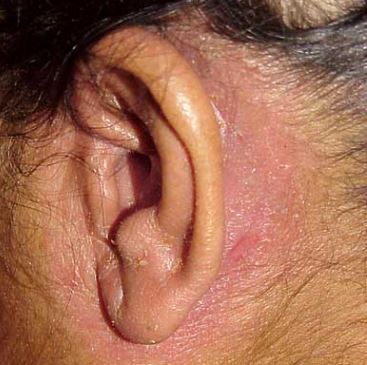
Psoriasis is a relatively common, chronic skin condition. It can be found in both children and adults, although it is most commonly diagnosed in early adulthood. It is an autoimmune disease that causes the skin’s life cycle to accelerate. Dead skin cells rapidly accumulate and create rough, dry, red patches or scales that can itch or hurt. A Centers for Disease Control and Prevention study estimated that 5 million people in the United States have psoriasis.
There are some cases where you experience pain or itching on the skin around your ear. This if looked into keenly might be an indication of psoriasis. If this is the case, you might notice a buildup of skin scales or wax in the external area of your ear. This can make hearing difficult. According to the International Eczema and Psoriasis Foundation (IEPF), up to 18 percent of people diagnosed with psoriasis will end up with patches of affected skin on or near their ears.
The National Psoriasis Foundation explains that psoriasis usually occurs in the external ear canal. Regardless of where on your ear it occurs, you may have a buildup of scales or wax, making it difficult to hear.
You are likely to have some symptoms and they include:
- Small or large areas of irritated skin that won’t heal
- Dry or cracked skin that bleeds
- Nails with pits or ridges on them
- Joints that feel swollen or rigid (part of psoriatic arthritis)
- Temporary hearing loss from blocked ears
It is a common occurrence for psoriasis in the ear to spread onto the face. You might notice it around your eyes, mouth, and nose. A small number of people may even find psoriasis on their gums, tongue, or the inside of their cheeks and lips.
There are other factors and conditions that are at a high probability of making you have dry skin behind the ears. The discussion below revolves around them:
- Contact allergic dermatitis is yet another suspect for this condition. It is one of the commonest causes of rash behind ears. It appears as red sometimes raised bump together with itching and soreness. Often chemicals in soaps and shampoos may be responsible for such rash. Wearing artificial ornaments may sometimes be responsible for allergic rash on and behind the ears. Especially those containing nickel are suspected to cause rash on skin.
- Measles: It is one of the very common childhood infections. The infection is caused by a virus. It is a respiratory disease, having its first symptom as raised red spots behind the ears, which spreads to trunk and eventually covers the whole body. The other associated symptoms of measles are high temperature, runny nose and dry cough. There is no cure once it occurs but in mild cases the recovery is swift. Immunization provides protection and is usually undertaken at nine to fifteen months of age.
- Sometimes, being too thorough about cleaning your ears frequently may strip your ears of natural oils. The production of wax may not be able to keep up with how fast one is removing it and the skin in the ears may become dry and start peeling. It may cause itching inside the ears.
- The other likely cause of this condition is the use of hearing aids. These aids may rub against the skin in the ears causing some dry skin in the ears. You should therefore consult your doctor for the proper aids and advice.
- The other very likely cause is fungus infection behind ears. This is common because of skin folds and entrapment of moisture in this area.
Treatment of dry skin behind the ear
Just like seborrheic dermatitis on the face and scalp, ear seborrheic dermatitis is treatable but not curable. That therefore implies, you can use medicated soaps, shampoos and creams to control the rash, but it will come back over time.
Depending on the type and severity of the rash, there may be home remedies and over-the-counter medications that can help with rash behind ear treatment and prevention of it spreading. It is also important to ensure the skin behind ears is always dry and clean to prevent rashes and other skin conditions.
It is very unfortunate that atopic dermatitis has no cure but symptoms can be treated with topical corticosteroids, such as hydrocortisone and vitamin D. Avoiding the trigger allergen would prevent the occurrence of the eczema, as it would with contact dermatitis. Anti-inch creams help with the symptoms until the rash disappears on its own.
In the event that it is established that Ear Infection is suspect for the condition, it may be wise to see if trying different soaps and cleaning products prevent the contact rash.
On the other hand, scalp psoriasis is treated with corticosteroid creams, phototherapy, and moisturizers for the symptoms. It is very unfortunate that no cure has been found yet for the total treatment of psoriasis.
In other cases when yeast or any other fungus are suspected to be the cause, anti-fungal medicine, ketoconazole, is used to treat skin infections; similarly, it has been effective for seborrheic dermatitis. The use of tea tree oil is also good to treat rashes as it is a natural antimicrobial. It can also be used for fungal or bacterial infections.
In other lucky cases, a rash behind ear can sometimes go unnoticed unless it develops into an itchy or painful rash. It is important to always maintain good hygiene by keeping the area clean and dry to prevent a rash from forming. Certain skin conditions that are unexplainable and unpreventable, however, must be attended to. Check out for the folds of your skin frequently and learn the cause of the rash before trying to treat it.
There is yet another way to approach the treatment of the dry skin behind the ear, but since there are number of causes for rash, it is important to determine the underlying cause. Once the cause is determined it is easier to treat. Suitable home remedies and precautions are useful in relieving most of the symptoms of rashes that occur behind the ear.
Precautions
Before finally coming to treat the condition, it is safe to take precautionary measures that will cushion you and prevent you from getting this condition. They may include:
- Avoid using hair dye if you are found allergic to them. Instead use natural hair dye which has no chemicals in them.
- If the condition is suspected to be due to chemicals, dyes and earrings, the cause for contact allergic dermatitis, try to change the product.
- Keep the area behind ear dry and clean. This will help in preventing fungal and bacterial infection behind the ear.
- Use dandruff shampoo when the cause is seborrheic dermatitis. The condition responds well to dandruff shampoo and steroid ointments.
- It is very important that you do not use cotton buds or q tips often on your ears as you may strip them of natural lubrication. If wax build up is a real concern for you, it is safer to approach an ENT specialist who can carry out a professional clean up. He will also recommend how often you will need a cleanup.
- You might from time to time be tempted to scratch your ears out of nervousness and anxiety. This may irritate the skin in the ear, or on the lobe and one may end up with some scabs if the scratching is frequent and vigorous. To avoid this, make a conscious effort to not scratch your ears, or poke objects into them
Home remedies
There are several approaches you can take before finally settling down to chemical treatment. The remedies are easy and simple to prepare and apply. They are readily available and seemingly very effective in the long run.
The first remedy you could opt for is tea tree oil. In order to do this:
- Apply tea tree oil on the lesion if the underlying cause is fungus infection.
- Use tea tree oil in diluted form.
- Mix few drops of it to a carrier oil such as olive oil.
- It is effective in dealing with rash which is accompanied with fungus infection.
According to the American Journal of Clinical Dermatology, the use of jojoba oil can be beneficial for easing skin affected by this condition.
You can try the following two-step process for using natural oil jojoba oil for psoriasis:
- You can find over-the-counter ear cleansing kits that involve squirting a small amount of warm water into your ear.
- Follow this up by applying a thin layer of jojoba oil to external areas with a cotton ball.
To add on the above list, applying turmeric paste helps in reducing inflammation and redness. Turmeric has inherent anti inflammatory properties which help in reducing redness and swelling associated with rash.
The other very important and useful option is garlic. It is known world-wide because it is a powerful natural antibiotic. In this remedy, you will heavily rely on its antibacterial properties to combat dry skin in ears. To do this,
- Crush some garlic cloves and mix in a tablespoon of olive oil.
- Heat up the mixture gently till you see it begin to bubble then leave to cool.
- Use this remedy as natural ear drops for itchy ears by applying with a dropper inside the ear.
The use of olive oil is also very helpful. In cases where the ear is not producing enough wax, you can use olive oil to act as the natural lubricant and ease the dryness. To do this,
- Apply two drops of pure olive oil using a dropper every time you feel the dryness.
The other very essential product is vinegar. Dilute vinegar mixed with some rubbing alcohol has been used as an effective ear dryness treatment.
Using a good moisturizer will dramatically improve conditions if the skin is already dry and damaged, and help prevent the problem from recurring. For those with sensitive skin, checking the labels of new body products for known irritants in the ingredients list can help them avoid making the problem worse.
There are creams and lotions which have collagen and silicone as main ingredients, and these may help improve the condition of dry, chapped, peeling skin behind your ears. It is therefore up to check with your dermatologist for the best remedy that would work for you.
References and Sources
- http://www.healthline.com/health/psoriasis/psoriasis-in-the-ears
- http://www.doctorshealthpress.com/skin-care-articles/rash-behind-the-ear-5-causes-and-treatments
- http://skin.knowfacts.org/dry-skin/dry-skin-ears-causes-treatment-remedies-get-rid-dry-itchy-flaky-crusty-skin-inside-ear-canal/
- http://www.tandurust.com/skincare/rash-behind-ears-causes-remedies.html
